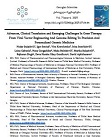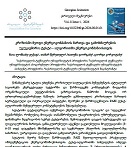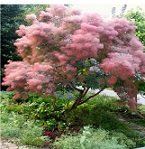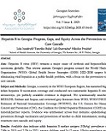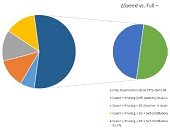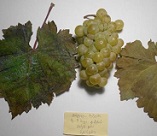Conversion processes of local raw materials considering the use of reactor-decarbonizer in rotary kiln system for clinker production
Downloads
In cement and clinker production energy consumption reduction, specific emissions reduction and quality stable increase always has been daily challenge which was addressed in many studies. Nowadays, CO2 emissions are under special focus since the gas is a main contributor in global warming and many other environmental topics. Considering existing challenges, the PhD study is addressing following:
- Revamping from wet process to the new dry line clinker production process
- Revamping from the old Kavtiskhevi quarry to new Saskhori quarry
- Raw meal, kiln feed and clinker quality adjustment after changing the type and amount of the fuel
- Study of clinkerization process based on the modified design
- Activation of puzzolanic material – Tuff in the clinker cooler
Clinker production process change from wet process to dry process was performed the way that clinker quality was at least the same but grindability of the clinker was increased with relatively lower lime saturation factor. Of course by avoiding drying wet slurry and making heat exchange process more efficient due to more dispersive, powderous material the heat consumption was reduced twice and capacity of the kiln line was doubled. The difficulties caused by switching the Kavtishkevi quarry were solved by using Saskhori limestone as a main source and Dedopsitskaro limestone was used as a sweetener, which contains more than 95% calcium carbonate. This substitution took place in such a way that it did not have a negative impact on the quality of the clinker and on the contrary made it more stable and active. After reducing coal and thus ash by 2 times, raw flour chemistry was recalculated so that the quality of clinker was the same or increased. Appropriate recalculation was done at all stages of trials. The clinker process burning with a new method was studied and optimized. As a result of 20 industrial experiments of raw material and fuel distribution, the best mixes were determined, by means of which the quality of clinker increases or remains the same, while the thermal consumption was reduced as was CO2 emissions from fuel and from raw meal. The most important achievement was the thermal activation of Tuff (Zeolite), which was successfully completed not only in the laboratory but also in the industrial experiment. The origin of the innovative idea was that the drying out of physically bound water makes the puzzolanic material much more active due to created pores. The material usage (with clinker) up to 10% in relation to clinker not only preserves but also increases the strength of this mix compared to clinker. The method of activation of existing puzzolanic material has been studied since the ancient Roman period. However, the activation of the puzzolanic additive requires less thermal energy than the clinker, and therefore also emits additional CO2 emissions. Therefore, the puzzolanic material activated by the standard approach reduces emissions, thermal and other costs relatively less, and also requires an investment of at least 10 million and an installation period of at least 6 months. Based on a complete study of the clinker production processes, a section was identified where the temperature ranges from 600°C to 1200°C and we use ambient air to reduce it. This section is a clinker cooler, where clinker heated at temperatures 1200-1300°C is coming out of from the rotary kiln. The clinker is passing a 30-meter cooler and cools down to about 100°C. The temperatures we wanted were 5 to 10 meters from the hot side. 10 meters away from the hot end, a material discharge chute was arranged, where tuff is supplied with transport conveyors and hopper. The production experiment with a dose of 5% was successful, but it is also possible to increase the proportions to 10% in the following trials. Also, the feeding point on the clinker cooler roof can be moved to the hotter side, which will further activate the tuff and allow us to increase its percentage in the clinker. The most important is that this experiment allowed us to produce 100% clinker with 90% emissions and thermal consumption, which is an incredible result globally, especially for CO2 reduction. The project was implemented with minimal costs (200,000 GEL) and, most importantly, does not include the thermal energy obtained with fuel, which almost cancels the operating costs and emissions. This section of the clinker cooler can be studied to use for drying and heating any other cement additive material.
Downloads
Metrics

This work is licensed under a Creative Commons Attribution-NonCommercial-NoDerivatives 4.0 International License.
































